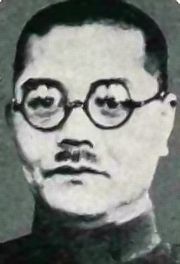- Hideo Iwakuro
-
Hideo Iwakuro 
General Hideo IwakuroBorn October 10, 1897
Hiroshima prefecture, JapanDied November 22, 1970 (aged 73) Allegiance Empire of Japan Service/branch  Imperial Japanese Army
Imperial Japanese ArmyYears of service 1918 -1945 Rank General Battles/wars Siberian Intervention
Second Sino-Japanese War
World War IIIn this Japanese name, the family name is "Iwakuro".Hideo Iwakuro (岩畔 豪雄 Iwakuro Hideo, 10 October 1897 – 22 November 1970) was a general in the Imperial Japanese Army during World War II.
Contents
Biography
Early career
Iwakuro was born on Kurahashi-jima in the Inland Sea (then part of Aki County, Hiroshima prefecture). Although he grew up on the island neighboring Etajima (where the Imperial Japanese Naval Academy was located), Iwakuro had no interest in a naval career, and was sent for schooling to a military academy in Nagoya. He graduated from the 30th class of the Imperial Japanese Army Academy in 1918, and was assigned to the 16th Infantry Regiment, based at Shibata city in the Hokuetsu region of Japan.
In September 1920, Iwakuro's regiment was assigned as part of the Japanese expeditionary force participating in the Siberian Intervention, and Iwakuro participated in numerous combat missions against Bolshevik partisans. In 1921, Iwakuro was transferred to the Taiwan Army of Japan, and was based in Taichung. He returned to mainland Japan in 1926 to attend the 38th class of the Army War College (Japan), and it was shortly after graduation that he became a member of the Sakura Kai ultranationalist secret society. In 1932, he was transferred to Manchuria shortly after the Manchurian Incident and assigned to the Kwangtung Army, where he held a number of staff positions and was actively involved in planning the independence of Manchukuo, and its future economic development under Imperial Japanese Army management.
Spymaster
Iwakuro was recalled to Japan shortly after the February 26 Incident of 1936, and was a member of the court marshal of the perpetrators. He was then assigned to Army Intelligence, where he oversaw the wiretapping of foreign embassies, interception of mail and correspondence and the production of counterfeit money for use in future operations. In 1937, he was transferred to the newly created 8th Section of the Imperial Japanese Army General Staff, and was tasked with planning the independence of Wang Jingwei's Nanjing Nationalist Chinese government. In 1938, he was on the committee which established the Nakano School, Japan's training school for intelligence and counter-intelligence agents.
From 1939-1941, Iwakuro was Chief of Army Affairs Section in the Military Affairs Bureau, where his primary task was military procurement. Using the Tripartite Alliance, Iwakuro strongly pressed Nazi Germany to share military technologies, particularly in terms of armor and aviation-related technologies. He also established a research facility to investigate new technologies, such as microwaves, for potential military applications.
Iwakuro, unlike many in the Japanese Army senior staff, was always strongly against war with the Soviet Union and was conversely a strong proponent of the Nanshin-ron philosophy as were many senior offices in the Imperial Japanese Navy. With the defeat of the Japanese Army at Nomonhan Iwakuro became more outspoken in favor of the concept of a Greater East Asia Co-Prosperity Sphere and the need for Japan to prepare for total war.
Diplomat
Iwakuro was sent as military attaché to the United States in 1941 over the objections of Foreign Minister Yōsuke Matsuoka. However, the Army's position was that Matsuoka was too inexperienced in foreign affairs, and needed additional training. Iwakuro was a close adviser of Japanese ambassador Admiral Kichisaburō Nomura in the Washington negotiations just before the outbreak of the Pacific War[1] He was withdrawn after the formation of a new cabinet under Hideki Tōjō in August 1941, and was named Commanding Officer of the 5th Imperial Guards Regiment.
Command and Staff appointments
After the start of the Pacific War, the 5th Imperial Guards Regiment came under the command of the Southern Expeditionary Army Group, and was assigned to Malaya and Singapore. While in Singapore, Iwakuro became head of the I Kikan, and was senior liaison officer with the Indian National Army.[2]
In 1943, Iwakuro was promoted to Vice Chief of Staff of the Twenty-Fifth Army. He subsequently became Chief of Staff of the Twenty-Eighth Army in Burma in 1944-5.[3]
Recalled to Japan before the end of the war, Iwakuro was attached to Army Ordnance Administrative Headquarters in 1945, and was Head of Army Investigation Department at the time of the end of the war.
After the war, in 1965, Iwakuro became one of the founders of the Kyoto Sangyo University. He died in 1970 of Myocardial Infarction.
References
Books
- Barrett, David (2001). Chinese Collaboration with Japan, 1932-1945: The Limits of Accommodation. Stanford University Press. ISBN 0804737681.
- Lebra, Joyce C. (1977). Japanese trained Armies in South-East Asia. New York: Columbia University Press. ISBN 0231039956.
- Mercado, Stephen C. (2002). The Shadow Warriors of Nakano: A History of the Imperial Japanese Army's Elite Intelligence School. Potomac Books Inc. ISBN 1574884433.
External links
- Ammenthorp, Steen. "Hideo Iwakuro". The Generals of World War II. http://www.generals.dk/general/Iwakuro/Hideo/Japan.html.
Notes
- ^ Review Of The Diplomatic Conversations
- ^ Lebra, Japanese-trained Armies of Southeast Asia
- ^ Ammenthorp, The Generals of World War II
Categories:- 1897 births
- 1970 deaths
- People from Kure, Hiroshima
- Japanese generals
- Japanese spies
- Japanese military personnel of World War II
- Indian National Army
- Deaths from myocardial infarction
Wikimedia Foundation. 2010.
